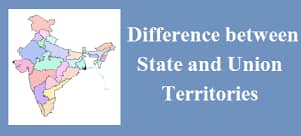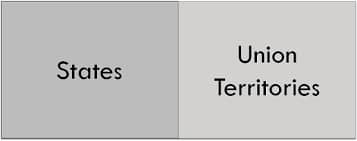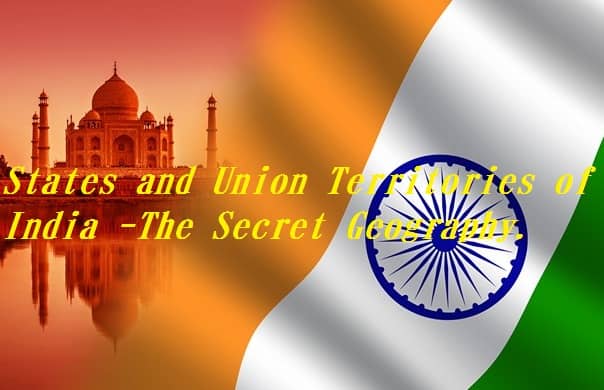India, located in South Asia, is one of the largest countries in the world in terms of democracy. Thus there is a systematic and functioning difference between States and Union Territories.
The diversity of India can easily be understood by the fact that the administrative powers and headed responsibilities are divided among central government in various units in form of States and Union Territories, a country known to be the kaleidoscope of cultures, traditions and religious beliefs, India is diversified with its citizens and geography.
India is a Federal Union comprising 28 states & 8 union territories, after inclusion of Jammu & Kashmir and Ladakh. These States and Union Territories are subdivided into districts and smaller administrative divisions.
(1) History of Creation:
Here we’ll be discussing the historical differences between States and Union Territories:
- Pre-independence: Our country has been ruled by many ethnic groups, throughout its history, each owning their own policies and administrative systems. During British Rule, the preceding “Mughal’s” administrative system was mostly followed. India was divided into several “Presidencies”, governed by British and princely states.
- 1940-1970: Between 1940’s to 1970’s, the territories of princely states were integrated into Indian Unions. Most of them merged out of existed provinces itself, but some of them were made up and added as new unions. The constitution of India, forced on 26th January 1950, made a new reign of sovereignties. It was divided in 4 parts:
- Part A : These states were the former provinces of British India; ruled by “State Legislature”; included 9 states- Assam, Bihar, Madhya Pradesh, Bombay, Punjab, West Bengal, U.P., Orissa, & Madras.
- Part B: These states were formed by groups of princely states; ruled by “Rajpramukh”; included 8 states- Hyderabad, Jammu & Kashmir, Madhya Bharat, Mysore, Patiala, Rajasthan, Saurashtra, & Travancore-Cochin.
- Part C: These States included both new and former princely states; ruled by “Chief Commissioner”; included 10 states- Ajmer, Bhopal, Bilaspur, Coorg, Delhi, H.P., Kutch, Manipur, Tripura, & Vindhya Pradesh.
- Part D: The only part included Andaman & Nicobar Islands; ruled by a “Lieutenant Governor”.
- States Recognition: (a) In 1953, Andhra State was created out of Madras State.
(b) In 1961, Portuguese-enclave, “Dadar & Nagar Haveli” was annexed to be as Union Territory.
(c) In 1962, “Pondicherry” was named to Union Territory.
(d) The States Recognition Act 1956, recognized to build linguistic states. As a result, Madras State was retained to “Kanyakumari District”. Andhra State was merged with Hyderabad creating a new state “Andhra Pradesh”.
(e) “Kerala” was created out of Madras State. The Laccadive and Minicoy Islands of Madras State was organized into Union Territory of “Lakshadweep”.
(f) Bombay State was enlarged with Saurashtra State.
(g) Bihar was transferred to West Bengal.
(h) “Rajasthan” & “Punjab” gained the title of State Unions.
- 1956 & after: (a) By 1960, Bombay & Saurashtra States were merged to new State Union of “Maharashtra” & “Gujarat”.
(b) “Nagaland” achieved the Statehood title in 1963.
(c) The Punjab Reorganization Act 1966 gave 4 new states, “Punjab, Haryana, Chandigarh & Himachal Pradesh”.
(d) Kanyakumari was finally renamed to “Tamil Nadu” in 1969.
(e) In 1972, the 3 new eastern states were formed as “Manipur, Meghalaya, & Tripura”. Mysore was named as “Karnataka” in 1973 and in 1975 “Sikkim” also got its statehood free from state monarchy.
(f) In 1987, eastern states got 2 new friend states in list- “Arunachal Pradesh & Mizoram”, followed by statehood of “Goa”. “Daman & Diu” also got the rank hold of Union Territories.
(g) By 2000, 3 new states were added in the list- “Chhattisgarh, Uttar Pradesh & Jharkhand”.
(h) In 2014, a new state was formed- “Telangana” separated by Andhra Pradesh.
(i) In 2019, after revocation of Article 370 from Jammu & Kashmir has been divided into 2 Union Territories- Jammu and Kashmir & Ladakh.
This how the states and union territories of India were formed and govern with respective central & state administrative systems.
(2) India- Country with Asymmetric Federalism:
The main forms of administration in India are the Centre & the States. But there are other forms too. Besides Centre & States, the country has Union Territories with and without Legislatures. When the constitution came into force, the provinces were divided into 4 parts. Some of them were recognized both as States & Union Territories.
Puducherry, Delhi & Jammu & Kashmir were recognized as Union Territories having legislatures, while others don’t have legislature or ministerial council. But the 3 also have differences; Puducherry has legislative powers on all acts in Concurrent list so far it’s applied to Union Territories. Whereas Delhi, much enlarged in terms of Land, Public & Police, has its powers are outside the purview of any list.
Just as the Centre and the States do not have the same residing powers, there are way differences in working of States and other constituents of Indian Union towards Centre. This creates a notable asymmetry in the way Indian Federalism works, creating differences between States & Union territories.

(3) Differences between States and Union Territories :
Here are some of the important points which will duely make us understand what the differences between States and Union Territories is:
- A state is an independent unit which consists of its own Legislative Assembly with elected representatives. In other words, a State is one having its own Chief Minister. The basic functions such as security, healthcare, revenue, power etc. are handled by the State government.
Whereas,
Union Territory is that type of administrative system which is held and controlled by the Central government. We can say that Union Territories are ruled by the Central government having a Lieutenant Governor who is representative of President of India.
- There are 28 States which are having their own Chief Ministers and 8 Union Territories out of which 5 are without legislatures and 3 have the legislative assemblies.
- A-State is administered by the Chief Minister and elected by the people, whereas, Union Territories have administrator elected by honourable President.
- A-State is relatively larger in terms of area, population and overall development from Union Territories. The largest State in terms of area is Rajasthan and smallest is Goa. The largest Union Territory in terms of area is Jammu & Kashmir and smallest is Lakshadweep.
- A State possesses autonomy while union territory doesn’t have any autonomy.
- A State enjoys a federal relationship with the central government. The legislative & executive powers are distributed among units of the system, whereas, Union Territories celebrates a unitary relationship with Central government residing all the executive and legislative powers to the union.
- The States have a representative in both Lok Sabha and Rajya Sabha, whereas, Union Territories have no representation at Rajya Sabha, except Delhi and Puducherry.
Also Read: Difference between Lok Sabha and Rajya Sabha
(4) States and Union Territories:

As previously discussed, India has 28 States & 8 Union Territories. The differences between States and Union Territories are discussed above. Here are some other facts about them.
- States are governed and ruled by the single owned political party who is in power as “Member of Legislative Assembly”. All the States have their own Legislature in form of Chief Minister.
- Union Territories are of 2 types:
India has 2 types of Union Territories- Territories with Legislature, Territories without Legislature.
- The territories having legislatures are Delhi & Puducherry have elected legislature and government.
- The other union territories are directly governed by the president as “Lieutenant Governor”.
- After the bifurcation, Jammu & Kashmir is also included in the same category of Puducherry and Delhi. The powers will now be distributed among Chief Minister and governor.
The education and municipal operations of these Territories come under the power of the legislative assembly. The security and other conditional operations are under advice of “Lieutenant Governor”.
Thus these Union Territories enjoy the status of Statehood and having its own assemblies, do not work as same as other 5 works. These fully explain the differences between States and Union Territories.
(5) Why should Delhi be considered as State?
The burden of a never-ending tussle between Union and Delhi government makes its citizens to suffer. Delhi enjoys the character of a special Union Territory, with a few unique institutions, like an elected Legislative Assembly and a High Court.
Here I’ll explain the differences between States and Union Territories with Delhi as an example:
-
The Chief Minister-Centre Tensions:
It is, however, not a full state; a point also reiterated by the Delhi High Court on 4 August. This implies that powers in Delhi are divided between the Chief Minister and the Centre, through the Lieutenant-Governor.
The system of Delhi governance is that Lieutenant-Governor Najeeb Jung is the “administrative head” of the National Capital-Union Territory, barring Delhi Chief Minister Arvind Kejriwal’s dreams of witnessing Delhi get full statehood.
A double control governing system not only creates inculcated tension, it also grows unfair on the elected government. When people vote for a government in the state, their concern is how matters of law and order are handled, and not how they are getting executed.
-
Jurisdiction Covariance:
In 2019, our Union Minister, Venkaiah Naidu announced and surplused many districts under NCR.
NCR is already one of India’s largest and most populated regions, confined with almost 5 Cr. people in it.
-
Global appearance:
Delhi, being the National Capital of India, stands with all the recognition that a state can undergo. The global cases of Delhi are much enough to argue over its statehood. The capitalization, industrialization and urbanization are 3 pillars of developed Delhi making it stand in list of statehood.
(6) Factors considered for the creation of States and Union Territories:
The major differences between States and Union Territories will be well explained when we come to know what the factors that led their creation are:
- Preservation and Strengthening of the Unity and Security of the Nation.
- Expressive and Cultural Homogeneity.
- Political and administrative considerations of people and system.
- Financial, economic and Administrative Considerations of People.
- Planning and promotion of the welfare of the people in each state as well as of the nation as a whole.
- Special treatment and care of the Backward and tribal people.
(7) Responsibilities and Functioning of States and Union Territories:
The constitution of India distributes the Sovereign, Executive and Legislative powers among States and Union Territories with each one functioning differently and effectively.
- Formulation, Execution, Evaluation & Revision of public policy with various practices.
- Coordination among various ministries of organs of government.
- Preparation of legislative agendas.
- Financial management with fiscal control and operations.
- Providing Educational and Security support to its citizens.
- The government has to provide support for agricultural purposes also. Etc.
Conclusion:
India is a country of diversity, diversified units of cultural, tradition, religion, and people etc. The States and Union Territories of India are its identities and the source of administrative powers. Both States and Union Territories acts differently, both have different working systems and processes, yet they both together unites and forms the administrative power of our country.
The differences between States and Union Territories are well explained here and this article includes much of the information. By: Nikhil Nivedan Vatsa

Informative!! It was a great article got to know about union territories.
Thanks Ritika
Informative one..Keep it up Nikhil.. great going
Thank you
Explained well , nicely articulated ! Kudos Nikhil .
Thanks Mr. Avinash